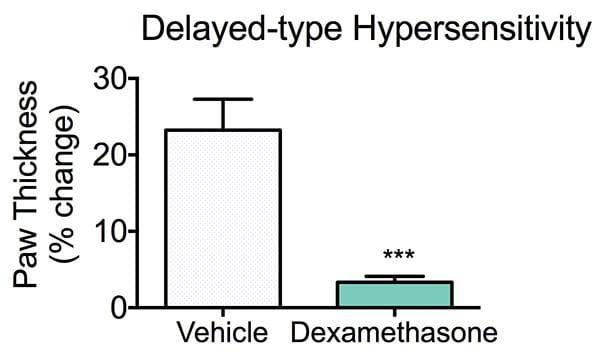Delayed Type Hypersensitivity
Discover how Melior’s unique phenotypic screening platforms can uncover the untapped value of your candidate therapeutic
Delayed type hypersensitivity (DTH) reactions are antigen-specific cell-mediated immune responses that can invoke harmful aspects of immune function (e.g., allergic dermatitis and autoimmunity).
The immune reaction induced by the method described below is characterized by swelling at the site of challenge and by an infiltration of monocytes/macrophages and lymphocytes into the epidermis and dermis.
This model for skin DTH reactions has been widely used to monitor cell-mediated immune responses in vivo. Melior has established a model of delayed type hypersensitivity using sheep red blood cells (SRBC) as the antigen. Dexamethasone, a steroid anti-inflammatory, was employed to pharmacologically validate the assay.
Ready to get started or looking for a custom model?
Contact us today for more information about our bespoke research models and to discuss how we can help you answer your unique research questions.

Delayed type hypersensitivity. On Day 1 of the study, mice were IV injected with washed sheep red blood cells (SRBC). On Day 6 of the study, mice were treated with either vehicle or Dexamethasone followed by injection of SRBCs into the paws. Injection of SRBCs into the paws of sensitized mice produced an allergic reaction as measured by swelling (paw thickness). Dexamethasone, a steroid anti-inflammatory, significantly reduced footpad swelling as measured using a microcaliper. Data are mean ± SEM; ***p<0.001 compared to vehicle (N=7-8).
The mouse DTH model is a test against an immunological inflammatory response. Animals that received vehicle treatment displayed an increased paw thickness compared to animals administered Dexamethasone, providing an immunological benefit. These data demonstrate a valid methodology for producing an allergic reaction in experimental animals and show that these animals are sensitive to pharmacological agents that are known to reduce allergic reactions.



 Interested in running a Delayed Type Hypersensitivity study?
Interested in running a Delayed Type Hypersensitivity study?